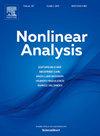Stability of positive radial steady states for the parabolic Hénon–Lane–Emden system
IF 1.3
2区 数学
Q1 MATHEMATICS
引用次数: 0
Abstract
When it comes to the nonlinear heat equation , the stability of positive radial steady states in the supercritical case was established in the classical paper by Gui, Ni and Wang. We extend this result to systems of reaction–diffusion equations by studying the positive radial steady states of the parabolic Hénon–Lane–Emden system where , and . Assume that lies either on or above the Joseph–Lundgren critical curve which arose in the work of Chen, Dupaigne and Ghergu. Then all positive radial steady states have the same asymptotic behavior at infinity, and they are all stable solutions of the parabolic Hénon–Lane–Emden system in .
抛物型hsamnon - lane - emden系统正径向稳态的稳定性
对于非线性热方程ut−Δu=up, Gui、Ni和Wang在经典论文中建立了超临界情况下径向正稳态的稳定性。通过研究抛物型h - lane - emden系统ut−Δu=|x| kvpinrnx(0,∞),vt−Δv=|x| luqinrnx(0,∞),其中k,l≥0,p,q≥1,pq>;1的正径向稳态,我们将这一结果推广到反应扩散方程系统。假设(p,q)位于Joseph-Lundgren临界曲线上或之上,该曲线由Chen、Dupaigne和Ghergu提出。那么所有正径向稳态在无穷远处都具有相同的渐近性质,它们都是Rn中抛物型h - lane - emden系统的稳定解。
本文章由计算机程序翻译,如有差异,请以英文原文为准。
求助全文
约1分钟内获得全文
求助全文
来源期刊
CiteScore
3.30
自引率
0.00%
发文量
265
审稿时长
60 days
期刊介绍:
Nonlinear Analysis focuses on papers that address significant problems in Nonlinear Analysis that have a sustainable and important impact on the development of new directions in the theory as well as potential applications. Review articles on important topics in Nonlinear Analysis are welcome as well. In particular, only papers within the areas of specialization of the Editorial Board Members will be considered. Authors are encouraged to check the areas of expertise of the Editorial Board in order to decide whether or not their papers are appropriate for this journal. The journal aims to apply very high standards in accepting papers for publication.

 求助内容:
求助内容: 应助结果提醒方式:
应助结果提醒方式:


